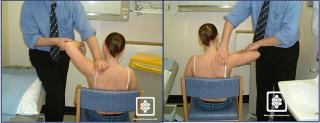The hyperabduction test: AN ASSESSMENT OF THE LAXITY OF THE INFERIOR GLENOHUMERAL LIGAMENT
Authors: O. J. Gagey and N. Gagey
References: J Bone Joint Surg Br, Jan 2001; 83-B: 69 - 74.
We studied 100 fresh human shoulders in cadavers (mean age 76 years), and the range of passive abduction (RPA) in 100 volunteers with normal shoulders and in 90 patients with instability of the joint, over a period of six years.
The anatomical and clinical findings showed that passive abduction occurs within the glenohumeral joint only, is controlled by the inferior glenohumeral ligament and has a constant value in 95% of both shoulders in normal subjects. In patients with instability, 85% showed an RPA of over 105° with 90° in the contralateral shoulder. In the remaining patients a strongly positive apprehension test suggested a diagnosis of instability.
An RPA of more than 105° is associated with lengthening and laxity of the inferior glenohumeral ligament.



